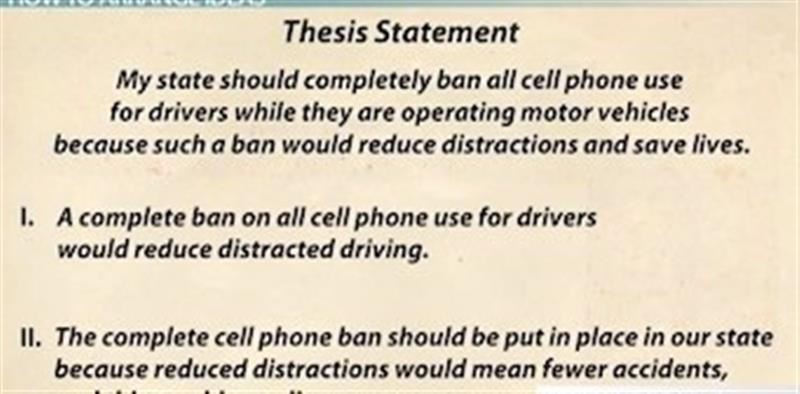How to Arrange Ideas
We don't have to come up with good points of argument at the outlining stage, as we've already done some prewriting. Let's take a look at the points that we came up with during our brainstorming process:
- Would cut down on distracted driving
- Would reduce accidents, save lives
- Making calls can be just as distracting as texting
- Would send a message that no distractions are acceptable while driving
During the prewriting stage, we brainstormed for ideas, but we didn't worry about grammar, whether the ideas would all definitely be useable or what order we should put them in. Now is the time to think about sentence structure, quality of ideas and logical order.
We already decided, when drafting our thesis statement, that our first two ideas - would cut down on distracted driving and would reduce accidents, save lives - were important ones to include in our paper. Looking at our brainstorming list, in fact, those two ideas would make sense as our first and second major ideas. The very first logical point that comes to mind when arguing in favor of a complete cell phone ban for drivers is that it would prevent distractions. That idea leads logically to the next point, that accidents would be prevented, thereby saving lives.
I mentioned a moment ago that we should think a bit about grammar at this point. It's useful to think about topic sentences while outlining. A topic sentence is the sentence that expresses the main idea of a body paragraph or group of related body paragraphs. A topic sentence is often the very first sentence of a paragraph. We could turn our first two brainstorming ideas - which we originally wrote as sentence fragments - into complete sentences so that they can work as topic sentences for our first and second body paragraphs:
- Our first idea could become: 'A complete ban on all cell phone use for drivers would reduce distracted driving.'
- Our second idea could become: 'The complete cell phone ban should be put in place in our state because reduced distractions would mean fewer accidents, and this would save lives.'
Thus far, our outline looks like the one below, with our thesis at the top, and our first two topic sentences comprising the first two Roman numeral entries, indicating that they are our first two ideas.
kkk

Let's now take a look at our other brainstorming ideas to see if they might be useful. In persuasive essays, it's a good idea to address what you think someone arguing the other side of the issue might say. Someone on the other side might point out that some states ban texting while driving and that that's enough. We could, therefore, use as a counterargument our major idea that making calls can be just as distracting as texting. Let's add that to our outline.
We might further argue that drivers engage in far too much risky behavior and that all drivers should be reminded that no distractions are okay, including taking or making calls. Therefore, our last idea - would send a message that no distractions are acceptable while driving - can be a strong final point for our outline. That idea can be reworked into this topic sentence: 'A ban on all cell phone use for drivers would send a message that no distractions are acceptable for drivers.'
Four major points of argument would be suitable for many short academic essays, so we're off to a good start. But we still have more to do. Let's look at our first major idea and consider what sub-points and details might go along with it. Remember that the more we flesh out our outline, the easier it will be to write the actual essay.
We'll plan to devote one body paragraph to each of our four major ideas. What will we need to discuss to support our first major idea that the cell phone use ban would reduce distracted driving?
We might use our common sense to note that any cell phone use can divert drivers' attention from the road, even if it's for a second or two. We therefore have our first sub-point: 'Even brief attention paid to a cell phone means that a driver is not watching the road.'
We'll need details and examples to support this assertion. Some of these details might be derived from our own experiences and observations. If we're writing a term paper, as opposed to a timed essay exam, we might have the opportunity to do some research, too. We could then look at books, periodicals and scholarly and/or professional websites to find data to support our arguments. We would of course have to cite any information that we get from our sources.